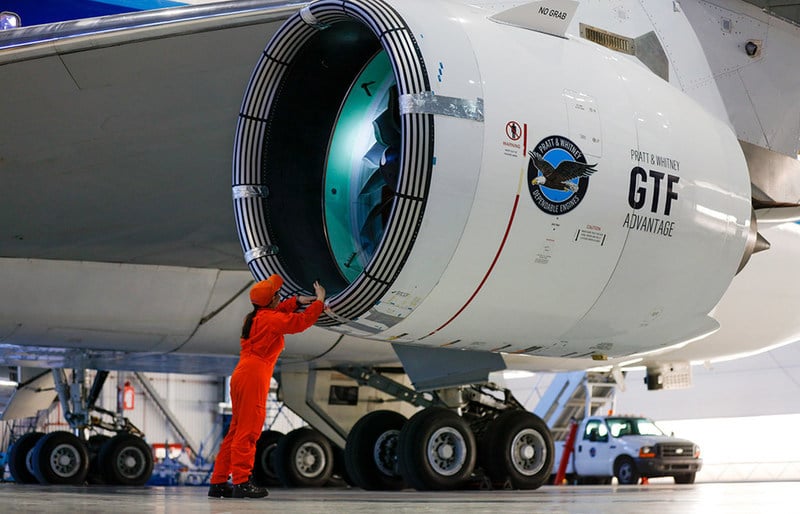Aerospace
NASA and Pratt & Whitney collaborate to develop low-emission aviation engine technology.
NASA has granted Pratt & Whitney a $13.1 million cost-share contract under HyTEC

To transform air travel and assist in the combat of climate change, NASA is starting a new phase of its aeronautics research. The agency’s Hybrid Thermally Efficient Core (HyTEC) project intends to enhance aircraft engine combustors to guarantee that commercial aviation is cleaner, more effective, and more environmentally friendly in the future.
NASA Orders Three More Orion Spacecraft From Lockheed Martin(Opens in a new browser tab)
NASA has granted Pratt & Whitney a $13.1 million cost-share contract under HyTEC. During the contract duration, Pratt & Whitney, based in Hartford, CT, will match or surpass NASA’s contribution. This two-year collaboration aims to advance innovative combustor designs for small-core engines. The combustor, also known as the combustion chamber in an aviation engine, is where fuel is mixed with compressed air and ignited to produce the high-temperature gas that powers the engine.
NASA and Pratt & Whitney will evaluate how well these upcoming combustor concepts perform when powered by sustainable aviation fuels as part of their revolutionary engine combustor work. By using less energy, running on renewable fuels instead of fossil fuels, and enabling electrified propulsion for single-aisle commercial aircraft, the HyTEC project will ultimately provide extremely efficient jet engines to enable the future of sustainable aviation.
Airbus and partners embark on SAF deliveries in China(Opens in a new browser tab)
By 2050, the U.S. fleet will have grown and will require 40% more jet fuel, according to the United States 2021 Aviation Climate Action Plan. Sustainable fuels are essential weapons in the industry’s toolbox to lower net carbon emissions from commercial aircraft, even though efficiency improvements like small core engines help to lower the fuel demand. The expected rise in the use of renewable fuels would drastically cut the emissions from aviation worldwide and slow the climate change rate brought by transportation.

Aerospace
Boeing Transfers Rocket Stage to NASA, Paving Way for Human Moon Mission

Boeing has achieved a significant milestone by providing NASA with the second core stage of the Space Launch System (SLS) rocket.
This crucial component, crafted at NASA’s Michoud Assembly Facility (MAF), is set to propel the Artemis II crew into lunar orbit, marking humanity’s return to deep space after a 50-year hiatus.
The monumental Boeing-built rocket stage, the largest element of the Artemis II mission, will embark on a journey aboard the Pegasus barge, traveling 900 miles to NASA’s Kennedy Space Center.
Comparison of two legendary aircraft B777x vs B747 aircraft:Click here
Upon arrival, it will be meticulously integrated with other essential Artemis II components, including the upper stage, solid rocket boosters, and NASA’s Orion spacecraft within the iconic Vehicle Assembly Building. This intricate integration process is a vital step toward the eagerly anticipated Artemis II launch, slated for 2025.
“Boeing-built products helped land humankind on the moon in 1969, and we’re proud to continue that legacy through the Artemis generation,” remarked Dave Dutcher, vice president and program manager for Boeing’s SLS program. “Together, with NASA and our industry partners and suppliers, we are building the world’s most capable rocket and paving the way to deep space through America’s rocket factory in New Orleans.”
NASA, Lockheed Martin Reveal X-59 Quiet Supersonic Aircraft:Click here
The delivery of Core Stage 2 marks a significant achievement in the evolution of the SLS rocket. Towering over 200 feet and powered by four RS-25 engines, this core stage, coupled with two solid-fueled booster rockets, will generate a staggering 8.8 million pounds of thrust. This immense power is crucial to launching Artemis II and future missions into the vast expanse of space.
The SLS rocket stands unparalleled in its capability to transport both crew and substantial cargo to the moon and beyond in a single launch. Its extraordinary capacity will facilitate the delivery of human-rated spacecraft, habitats, and scientific missions to destinations including the moon and Mars, ushering in a new era of space exploration.
-

 Travel1 week ago
Travel1 week agoAir India to Expand US Operations with Three New Routes After a Decade
-

 Travel2 weeks ago
Travel2 weeks agoWhy We Should Avoid These Stamps in a Passport
-

 Airlines1 month ago
Airlines1 month agoInvestigations Reveal Fake Chinese Titanium in Boeing and Airbus Jets
-

 Tech4 weeks ago
Tech4 weeks agoChina’s CATL Plans 1,800-Mile Electric Plane Launch by 2027
-

 Airport3 days ago
Airport3 days agoTop 10 Largest Airports in the World by Size
-

 Aerospace4 weeks ago
Aerospace4 weeks agoChina’s Fighter Jets Turn Wings into Autonomous Drones
-

 Airlines4 days ago
Airlines4 days agoAir India Rolls Out A350s for Delhi-New York JFK and Newark Routes
-

 Defence3 weeks ago
Defence3 weeks agoBoeing Enhances Chinook with New Engines and Block II Upgrades at $96 Million







